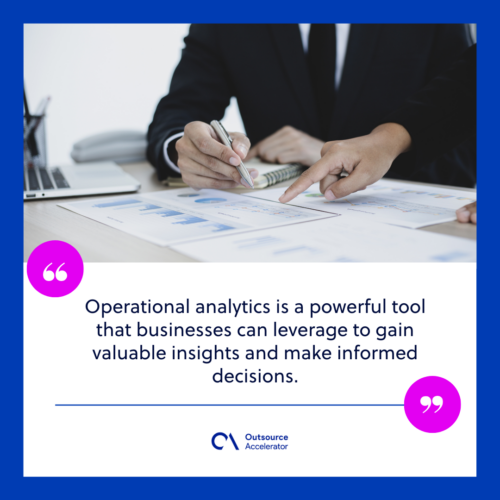A detailed breakdown of operational analytics

In an era defined by data abundance, global organizations face a pivotal challenge in instantly transforming big data into actionable insights.
Harnessing the power of data-driven insights has become more necessary. By 2025, it’s estimated that the global datasphere will encompass 175 zettabytes of data, equivalent to 175 trillion gigabytes.
This immense reservoir of information holds the key to unlocking operational excellence and achieving competitive advantage.
Real-time data processing poses both opportunities and challenges for businesses.
While it gives them a competitive edge in solving actual issues as they happen, teams can be overwhelmed by the volume of operational data and information they receive without proper process.
Operational analytics has emerged as a key to doing this. It’s a game-changer that firms should start taking advantage of.
This article explores operational analytics, its significance, methodologies, and tangible impact on businesses worldwide.
Defining operational analytics
Operational analytics involves collecting and analyzing data from various sources to translate into real-time insights. Data may even be collected from the organization’s own data warehouse.
The applications of operational analytics are as diverse as the industries they serve. It can be useful for various processes, from manufacturing plants optimizing production lines to e-commerce giants personalizing user experiences.
Businesses can leverage operational analytics as a powerful tool to gain valuable insights and make informed decisions. Business analytics from customer data enable them to serve their products better.

When to invest in operational analytics
While investing in operational analytics is most recommended for most verticals, specific reasons constitute the impending need to do this.
Here are the indicators of when firms should invest in operational analytics:
- Early growth phase. Startups and growing businesses should invest in operational analytics in their early growth phase, receiving a steady data flow. This helps them gain insights into customer behavior, market trends, and operational efficiency.
- Performance plateau. When you notice your business hitting a performance plateau, it’s time to dive into operational analytics. By analyzing data, you can identify bottlenecks or inefficiencies in your processes.
- Competitive pressure. When your competitors are gaining an edge through data-driven decisions, it’s a clear sign to invest. Analytics can help you stay competitive by providing insights into customer preferences and market trends.
- Customer-centric focus. If your business aims to be more customer-centric, operational analytics is a must. The strategy processes actionable user data, helping you understand customer behavior and preferences.
- Cybersecurity enhancement. Cybersecurity is paramount in protecting your overall operations. Operational analytics can help detect and prevent cyber threats.
- Strategic shifts. When your business undergoes significant strategic shifts, such as entering new markets or diversifying product lines, analytics can guide these transitions.
Applications of operational analytics in various processes
Operational analytics can be applied to various processes within a business, including:
Customer service
Operational analytics improves customer service by providing insights into customer behavior, preferences, and satisfaction levels.
Companies can use operational analytics platforms to identify first-time customers and help them get started with their products through quick start guides. It also detects which products are frequently purchased together so agents can upsell and cross-sell more easily.
This level of personalization can significantly enhance the overall customer experience.
Product development
Operational analytics is invaluable in guiding product development processes.
By analyzing market trends, customer feedback, and historical sales data, organizations can identify gaps in the market and make informed decisions about new product offerings.
For instance, a consumer electronics company can leverage operational analytics to identify emerging technologies and consumer preferences. This enables them to develop products that meet current market demands.
At the same time, operational analytics can help gather real-time feedback on software use patterns to help improve their products.
Customization
Operational analytics is a key enabler of customization. It allows organizations to tailor their products or services to individual customer needs based on the data they gather.
Businesses can create recommendations and offerings through customer preferences, gathering offers and promos to retain their loyalty to the brand.
Operational analytics provides businesses with the insights needed to deliver these personalized experiences.
Predictive maintenance
Utility companies implement operational analytics to spot malfunctions beforehand.
For example, electric companies use sensors and machine learning algorithms to monitor substation equipment. They collect data on temperature, vibration, and other key factors that may indicate impending failure.
When these algorithms detect anomalies, they can alert maintenance teams, who can then perform maintenance before a critical failure occurs.
Similarly, internet providers use operational analytics to monitor their servers and routers. They collect data on CPU usage, memory usage, and network traffic to detect when a server is overburdened.

Financial risk management
Moreover, financial companies use operational analytics to determine a customer’s credit risk
Credit companies assess a customer’s risk and determine their creditworthiness from credit reports, loan applications, and past payment history. Through machine learning algorithms, they can predict a customer’s propensity to repay a loan or credit card balance.
They use this data to assign credit scores that determine a customer’s creditworthiness, allowing them to decide whether to approve or deny credit.
Automated processes
Operational analytics plays a critical role in automating various processes within organizations.
Organizations can present choices, reduce errors, and improve efficiency by analyzing data from different sources and applying machine learning algorithms. It is best applied to filter customer tickets, prioritize urgent requests, and consolidate existing information.
These actions, in turn, can increase the team’s productivity since they won’t have to do manual tasks anymore.
How operational analytics benefit you
Implementing operational analytics can offer a range of benefits for businesses. Here are some of the key advantages:
Improved decision-making
One of the major benefits of operational analytics is that businesses can make data-driven decisions rather than relying on intuition or guesswork.
Management teams can gain insights and business intelligence, acting on the most effective strategies by analyzing real-time data.
Enhanced operational efficiency
Operational analytics leverages data to uncover inefficiencies in business processes. This enables businesses to streamline operations and eliminate bottlenecks.
Firms can optimize their workflows, identify areas for improvement, reduce costs, and increase overall efficiency.
Increased customer satisfaction
Businesses can better understand customer preferences, needs, and pain points by analyzing customer data and feedback.
This allows them to tailor their products and services to meet customer expectations, increasing customer satisfaction and loyalty.
Improved resource allocation
Operational analytics can help businesses optimize resource allocation by identifying areas where resources are underutilized or overutilized.
By analyzing resource usage and demand data, businesses can allocate resources more effectively, reducing waste and increasing productivity.
Better risk management
Operational analytics can help leaders identify and mitigate risks. Through historical data and trends, firms can anticipate potential risks they can face and take proactive measures to minimize their impact.
This includes planning contingencies, identifying vulnerabilities, and implementing risk mitigation strategies.

Competitive advantage
Implementing operational analytics can give businesses a competitive edge in the marketplace.
By leveraging data to drive decision-making and optimizing operations, brands can differentiate themselves from competitors and position themselves as industry leaders.
Best practices in implementing operational analytics
Implementing operational analytics requires careful planning and execution. Here are some best practices to consider:
Developing a data-driven strategy
Firstly, leaders should develop a data-driven strategy before diving into operational analytics. This involves setting clear objectives and identifying key performance indicators (KPIs) according to their business goals.
Defining these objectives lets businesses guide the data analysis process and ensure the insights gained are relevant and actionable.
Gathering and preparing relevant data
It is crucial to gather accurate and relevant data to drive meaningful insights. Companies should identify the data sources most relevant to their operational analytics goals and ensure high-quality data.
This may involve data cleaning, integration, and transformation to ensure the data is structured and ready for analysis.
Utilizing advanced analytics tools and technologies
Firms should leverage advanced operational analytics tools and technologies to analyze and make sense of data effectively. This can include data visualization tools and predictive analytics models.
These tools can help automate the analysis process and provide visualizations that facilitate understanding and decision-making.
Fostering a data-driven culture
Businesses should foster a data-driven culture to capitalize on operational analytics’s benefits fully.
This involves promoting data literacy among employees, encouraging data-driven decision-making, and providing the necessary resources and support for analytics initiatives.
By creating a culture that values data and embraces data-driven decision-making, businesses can ensure that operational analytics becomes an integral part of their operations.
Getting started with operational analytics
All in all, operational analytics is a valuable tool businesses can use to optimize operations, enhance customer experiences, and gain a competitive edge.
Whether a small startup or a large enterprise, operational analytics can provide the insights you need to succeed in today’s data-driven business landscape.
Implementing this strategy can seem daunting, but you can unlock valuable information and improve your operations with the right approach and tools.
Businesses can confidently embark on their operational analytics journey by:
- Developing a data-driven strategy
- Gathering and preparing relevant data
- Utilizing advanced analytics tools
- Fostering a data-driven culture
Remember, operational analytics is not a one-time effort. It requires continuous monitoring, analysis, and adaptation as operational needs change.
Using this properly can help firms stay ahead of the curve and reap the rewards of data-driven decision-making.







 Independent
Independent




